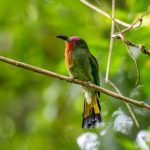This week a group of dedicated volunteers made the trip to 80 Mile Beach, in the north-west of Western Australia, to count the shorebirds. These MYSMA (Monitoring Yellow Sea Migrants in Australia – see eg http://www.awsg.org.au/pdfs/Report_on_MYSMA_surveys.pdf) counts have been done for several years and take place in July, November and December each year. It is the only time that vehicles go onto this stretch of beach and the shorebirds are in vast numbers.
It is a huge challenge to say the least! The huge ten metre tides prevent us from counting until the tide has come in to some extent and we really only have only two hours either side of the tide to get the counting done. It is not possible to count any more than 10 kilometres of shorebirds in this period of time and even that can be rather challenging. Ideally the flocks would stay put until they had been counted and then move north as we travel south or stay still! Once 5000 birds take flight you are really putting your skills to the test as you estimate the percentage of each species.
You can definitely get closer to birds in a vehicle than on foot and it’s quite amusing when an Australian Pipit seeks shelter from the searing heat under your vehicle whilst you count the shorebirds! Eighty kilometres of beach are covered by three vehicles over three days and it is amusing to see the Red-capped Plovers, Red-necked Stint and Greater Sand Plovers use the previous days vehicle tracks to shelter from the wind! The vast quantities of sea shells washed up over hundreds of years are quite something else. It is very hard to show the scale of the numbers of shorebirds that we are dealing with on this beach, but here’s a photo looking up the beach at several thousand shorebirds! Sorry about the heat haze!
We came across two different sea snakes washed up and they were both taken back to the sea to hopefully survive.

Stoke’s sea snake Astrotia stokesii

Dubois’ sea snake Aipysurus duboisii
We then ventured out in the evenings to watch Flatback turtles Natator depressus nesting on the beach as we had seen several returning to the sea in the morning when we set off to count shorebirds.
We also did some spotlighting to see what else was about and came across this Burton’s snake-lizard Lialis burtonis.
Once the counts of 80 Mile Beach were completed we then counted the birds in Roebuck Bay followed by the challenge of Bush Point, which is on the far side of Roebuck Bay. Although it is fairly close to Broome, as the birds fly, it involves quite a long devious drive across private land around the tidal inlets. It is a changing environment and every trip shows changes in the creek system.
Once again we had to plan carefully around the tides and cross the creek no less than two hours before high tide on foot and then attempt to count the shorebirds. One of the biggest problems is harassment by Lesser frigatebirds, but we were lucky on this trip and had no disturbance. Two islands have developed in recent years and this is another challenge. If no one goes out there then there’s a risk that the birds will remain there and not get counted. If you are out there and the birds then choose to leave at the height of the tide you will then be stranded for over an hour until the tide goes out!
This is by far the hardest place to count shorebirds, but also interesting because the population does not vary so much during the year. The flock of over 250 Pied Oystercatchers is impressive! I had the privilege of sitting with over 11,000 shorebirds on a very small island this week and chose to not return to the mainland until the tide had well and truly turned, as I had seen some shovel-nosed rays that were over 2 metres long! This is the view I had of the shorebirds from the telescope and it was quite overwhelming trying to work out how many of each species I had. I was hesitant to move even slightly, as they had become accustomed to my presence and I was worried they would take flight. The sea breeze was welcome, but the heat haze is a real problem.
A Flatback turtle was returning to the sea as we set off out across the mudflats and already a goanna (genus Varanus) had been at the nest site. Hopefully we do not get the predicted “higher than average” number of cyclones in the coming two months, or her nest will wash out. If the weather is cooler her eggs will become male turtles and if it is warmer they will become females.
These counts will be repeated in December, so we will hopefully have some more of interest to tell you all about and possibly more snake photos! And if it looks all a bit remote and harsh – that’s because that is exactly what it is!


















Leave a Comment